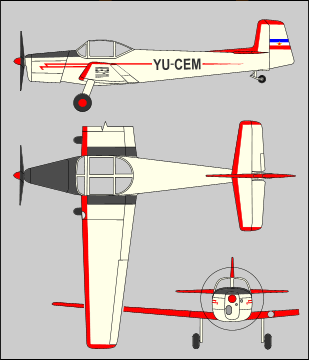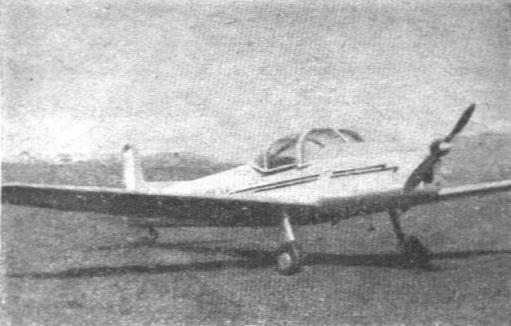KB-6 Matajur
| KB-6 Matajur first flew at the Ljubljana airfield in
Ljubljana-Polje on June 2, 1952. The aircraft was a two seater of wooden
construction. It was designed on lines of Zlin 22 which was really
Buecker Bestman, built in Czechoslovakia under license.
Matajur was designed to be a training aircraft but it could also be
used as an allround flight club plane. It was built in 'Letov' aircraft
factory that did a beautiful job on it though it only had experience in
building sailplanes. Everything except the undercarriage coil springs
was built in the factory which made everyone proud. |

Tests that followed showed that the plane surpassed all expectations - it flew like a lark. It was capable of basic aerobatics and it was also used for glider towing and parachute jumps. KB-6 Matajur is an all wood low winger. Wing is covered with plywood and fabric and it's central section is built into the fuselage. Flaps are used. Fuselage is also built from wood with formers and stringers and covered with plywood. The cockpit has a lot of room and offers good visibility. It slides backwards to open. There are two (later three) seats, the front two seats each having it's own control column and rudder pedals. Throttle and flap levers are mounted centrally. Fuel tank is located behind the left hand seat and the reserve fuel tank between the engine firewall and instrument panel. |

Main undercarriage legs are fitted to the central part of the wing and have coil springs in oil with the wheel brakes of hydraulic type. Tailwheel is connected to the rudder by a special coupling that disengages if the rudder is deflected too much. The rudder itself is covered with fabric and the fin and small dorsal fin with plywood. Horizontal stabilizer is also built from plywood and fabric with conventional trimmer tab on the right side. All control surfaces are mass balanced with lead weights. A wooden 1.95 m (6ft 4 3/4 in) dia propeller is used. Being built completely out of wood the aicraft was a bit heavy for it's class so some modifications were made. As already mentioned a third seat was added behind the right hand seat and at the same time a new engine was also fitted (Walter Minor 6 III with 160 HP). Unfortunately, these modifications were not as successful as it was hoped for as the plane lost it's aerobatic capabilities and with only three seats it could not really be considered a touring plane. The new engine was also a problem as it had some design flaws. The
back two cylinders of the 6 cylinder inline engine were not adequately
cooled, high RPM caused trouble with propellers and service life was
short. The engine problem was solved only years later when Matajur was
rebuilt as Libis 160, 185 and 210 (the number showing engine power), the
most popular being Libis 185 with a Lycoming 0-435-1 engine. |
| Data | Two seater | Three seater |
|---|---|---|
| Engine | Regnier 4 LOO, 136 HP | Walter Minor SW 6/III, 160 HP |
| Wing span | 10.60 m (34 ft 9 1/4 in) | 10.60 m (34 ft 9 1/4 in) |
| Length | 8.36 m (27 ft 5 in) | 8.36 m (27 ft 5 in) |
| Height | 2.15 m (7 ft 1/2 in) | 2.15 m (7 ft 1/2 in) |
| Wing area | 14 m2 (150.5 sq ft) | 14 m2 (150.5 sq ft) |
| Aspect ratio | 8 | 8 |
| Dihedral | 5.50o | 5.50o |
| Wing section | NACA 2415, USA 35B | NACA 2415, USA 35B |
| Empty weight | 659 kg (1,452 lbs) | 712 kg (1,568 lbs) |
| Max weight | 979 kg (2,156 lbs) | 1134 kg (2,498 lbs) |
| Wing loading | 70 kg/m2 (14.32 lb/sq ft) | 81 kg/m2 (16.57 lb/sq ft) |
| Power loading | 7.2 kg/HP (15.9 lb/HP) | 7.0 kg/HP (15.4 lb/HP) |
| Max speed | 222 km/h (120 kt) | 225 km/h (121 kt) |
| Cruising speed | 200 km/h (108 kt) | 170 km/h ( 92 kt) |
| Ceiling | 4500 m (14,754 ft) | 3500 m (11,475 ft) |
| Max climb rate | 3.6 m/sec (11.8 ft/sec) | 2.3 m/sec ( 7.5 ft/sec) |
| Range | 820 km (510 mi) | 550 km (342 mi) |